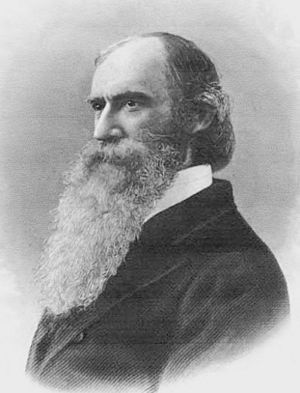John Strong Newberry facts for kids
Quick facts for kids
John Strong Newberry
|
|
|---|---|
 |
|
| Signature | |
John Strong Newberry (born December 22, 1822 – died December 7, 1892) was an American doctor, geologist, and paleontologist. A geologist studies rocks and the Earth's history, while a paleontologist studies fossils to learn about ancient life. Newberry explored the western United States on three trips, working as a scientist and a doctor. During the American Civil War, he helped soldiers through the US Sanitary Commission. After the war, he became a professor of geology and paleontology at Columbia University School of Mines.
Contents
John Strong Newberry's Life Story
John Strong Newberry was born in Windsor, Connecticut. When he was two years old, his family moved to Ohio, where his father started a coal mining business. The fossils found in the coal mines made him very interested in science. In 1841, he met James Hall, a famous geologist, which further sparked his interest.
Newberry went to Western Reserve College and then to Cleveland Medical School, finishing in 1848. That same year, he married Sarah Gaylord. They traveled to Paris, France, where he spent two years studying medicine and natural history. When he returned in 1851, he became a successful doctor in Cleveland.
Exploring the American West
In 1855, Newberry joined an expedition led by Lieutenant Williamson. This group was sent by the War Department to explore the land between San Francisco and the Columbia River.
From 1857 to 1858, he worked as the geologist for an expedition led by Lieutenant Joseph Christmas Ives. This team explored the Colorado River. Newberry was the first geologist known to visit the amazing Grand Canyon.
In 1859, he was the naturalist (a scientist who studies nature) on a trip led by Captain John N. Macomb. They explored parts of Colorado, Utah, Arizona, and New Mexico. On this trip, they found the remains of a dinosaur called Dystrophaeus.
In 1857, he was asked to become a professor at Columbian University (now George Washington University). He also became a member of the American Antiquarian Society in 1860.
Helping During the Civil War
Because of his medical knowledge and army experience, Newberry was chosen to be a member of the United States Sanitary Commission on June 14, 1861. This commission was like an early Red Cross, helping soldiers with medical care and supplies during the Civil War.
He first inspected troops in Cairo, Illinois. In September 1861, he left the Army and became the secretary of the Western Department of the Sanitary Commission. This meant he was in charge of all the commission's work in the Mississippi Valley, with his main office in Louisville, Kentucky.
Newberry set up the commission's system in this large area. He helped open the first supply center in Wheeling, West Virginia, which sent equipment to hospitals. He also encouraged many local groups to help. From 1861 to 1866, he managed a lot of money and distributed hospital supplies worth millions of dollars. During this time, the commission helped over 1,000,000 soldiers by providing food, shelter, and medical care.
After the War: A Professor and Scientist
In 1866, Newberry was offered a job as a professor of geology and paleontology at Columbia College (now Columbia University). He accepted and taught there for 24 years.
At Columbia, he built a huge museum with over 100,000 specimens, many of which he collected himself. This museum helped him teach about fossils and important minerals. It had some of the best examples of America's mineral resources and many unique fossils.
Newberry held many other important positions:
- Director of the Ohio Geological Survey
- Member of the Illinois Geological Survey
- President of the American Association for the Advancement of Science
- President of the New York Academy of Sciences
- President of the Torrey Botanical Club
He was also a judge at the World's Fair in Philadelphia in 1876. In 1887, he became an Associate Fellow of the American Academy of Arts and Sciences. He helped create the Geological Society of America in 1888 and was its president in 1891. In 1888, he received the Murchison Medal from the Geological Society of London, a big honor for geologists.
John Strong Newberry passed away in New Haven on December 7, 1892.
Newberry's Legacy
Many places and even an animal were named in honor of John Strong Newberry:
- Newberry Crater in Oregon (now part of the Newberry National Volcanic Monument) was named after him in 1903.
- Newberry Butte, a mountain in the Grand Canyon, was named for him in 1906.
- A fish, Eucyclogobius newberryi, also known as the Northern tidewater goby, was named in his honor.
See also
 In Spanish: John Strong Newberry para niños
In Spanish: John Strong Newberry para niños

